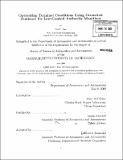| dc.contributor.advisor | Marc McConley and Emilio Frazzoli. | en_US |
| dc.contributor.author | Tisa, Paul C | en_US |
| dc.contributor.other | Massachusetts Institute of Technology. Dept. of Aeronautics and Astronautics. | en_US |
| dc.date.accessioned | 2009-10-01T15:45:09Z | |
| dc.date.available | 2009-10-01T15:45:09Z | |
| dc.date.copyright | 2008 | en_US |
| dc.date.issued | 2008 | en_US |
| dc.identifier.uri | http://hdl.handle.net/1721.1/47805 | |
| dc.description | Thesis (S.M.)--Massachusetts Institute of Technology, Dept. of Aeronautics and Astronautics, 2008. | en_US |
| dc.description | Includes bibliographical references (leaves 117-121). | en_US |
| dc.description.abstract | Small munition effectiveness is a function of miss distance from the target and ability to achieve a steep flight path angle at the target. Many small guided munitions have limited control authority to achieve these competing objectives due to system hardware tradeoffs. This thesis develops guidance algorithm modifications that demonstrate consistent improvement in achieving these objectives over previously used methods with changes only to the flight software and not the hardware or system concept of operations. Most modifications attempt to intelligently incorporate post-launch information into the guidance system, however there is an investigation into better using pre-launch information through dynamic programming. Dynamic programming is an off-line approach to optimize the guidance parameters applied in flight, based on measurable flight characteristics. All investigated methods demonstrate varying abilities to improve performance for this munition system. While dynamic programming is computationally intensive, it produces an efficient look up table which is easily implemented in real time with minimal additional memory requirements. The thesis further shows that performance improvements are gained by altering the rocket ignition time in flight, by tightening the tolerances on some key sources of modeling error, and by developing a highly accurate time to impact estimation algorithm. Regardless of the particular modification, better utilizing pre- and post-launch information improves the munition's performance and utility for the user. While not tested, simultaneously implementing several of these improvements could further increase performance. | en_US |
| dc.description.statementofresponsibility | by Paul C. Tisa. | en_US |
| dc.format.extent | 121 leaves | en_US |
| dc.language.iso | eng | en_US |
| dc.publisher | Massachusetts Institute of Technology | en_US |
| dc.rights | M.I.T. theses are protected by
copyright. They may be viewed from this source for any purpose, but
reproduction or distribution in any format is prohibited without written
permission. See provided URL for inquiries about permission. | en_US |
| dc.rights.uri | http://dspace.mit.edu/handle/1721.1/7582 | en_US |
| dc.subject | Aeronautics and Astronautics. | en_US |
| dc.title | Optimizing terminal conditions using geometric guidance for low-control authority munitions | en_US |
| dc.type | Thesis | en_US |
| dc.description.degree | S.M. | en_US |
| dc.contributor.department | Massachusetts Institute of Technology. Department of Aeronautics and Astronautics | |
| dc.identifier.oclc | 429047500 | en_US |
